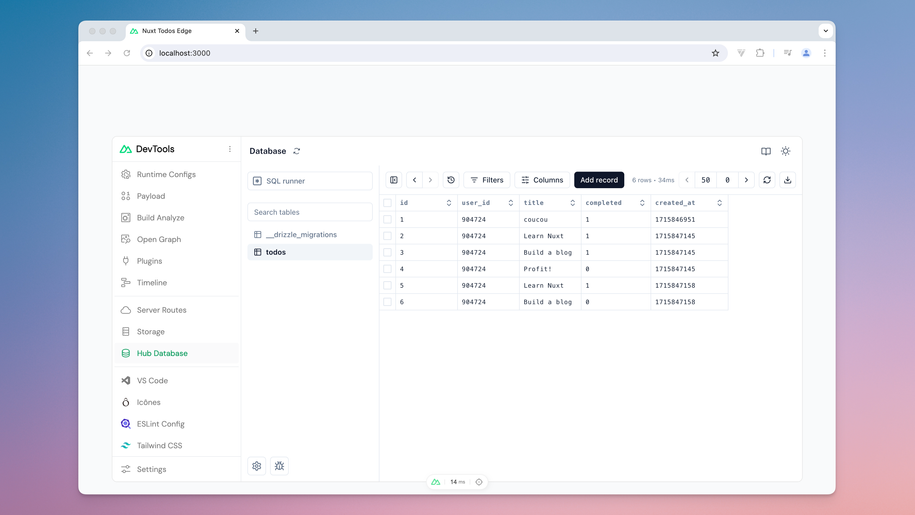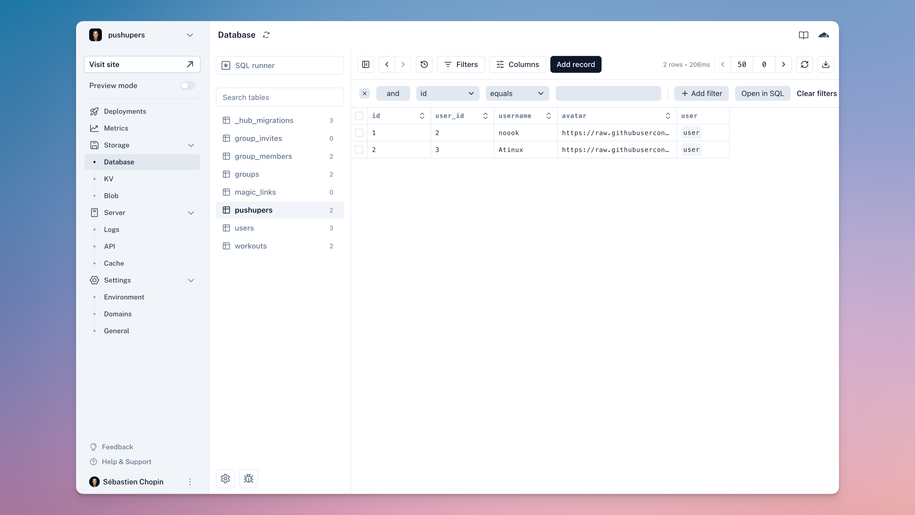SQL Database
NuxtHub Database uses Cloudflare D1, a managed, serverless database built on SQLite to store and retrieve relational data.
Getting Started
Enable the database in your NuxtHub project by adding the database property to the hub object in your nuxt.config.ts file.
export default defineNuxtConfig({
hub: {
database: true
}
})
During local development, you can view and edit your database in the Nuxt DevTools. Once your project is deployed, you can inspect the database in the NuxtHub Admin Dashboard.


hubDatabase()
Server composable that returns a D1 database client.
const db = hubDatabase()
prepare()
Generates a prepared statement to be used later.
const stmt = db.prepare('SELECT * FROM users WHERE name = "Evan You"')
bind()
Binds parameters to a prepared statement, allowing you to pass dynamic values to the query.
const stmt = db.prepare('SELECT * FROM users WHERE name = ?1')
stmt.bind('Evan You')
// SELECT * FROM users WHERE name = 'Evan You'
The ? character followed by a number (1-999) represents an ordered parameter. The number represents the position of the parameter when calling .bind(...params).
const stmt = db
.prepare('SELECT * FROM users WHERE name = ?2 AND age = ?1')
.bind(3, 'Leo Chopin')
// SELECT * FROM users WHERE name = 'Leo Chopin' AND age = 3
If you instead use anonymous parameters (without a number), the values passed to bind will be assigned in order to the ? placeholders in the query.
It's recommended to use ordered parameters to improve maintainable and ensure that removing or reordering parameters will not break your queries.
const stmt = db
.prepare('SELECT * FROM users WHERE name = ? AND age = ?')
.bind('Leo Chopin', 3)
// SELECT * FROM users WHERE name = 'Leo Chopin' AND age = 3
all()
Returns all rows as an array of objects, with each result row represented as an object on the results property (see Return Object).
const { results } = db.prepare('SELECT name, year FROM frameworks LIMIT 2').all()
console.log(results)
/*
[
{
name: "Laravel",
year: 2011,
},
{
name: "Nuxt",
year: 2016,
}
]
*/
The method return an object that contains the results (if applicable), the success status and a meta object:
{
results: array | null, // [] if empty, or null if it does not apply
success: boolean, // true if the operation was successful, false otherwise
meta: {
duration: number, // duration of the operation in milliseconds
rows_read: number, // the number of rows read (scanned) by this query
rows_written: number // the number of rows written by this query
}
}
first()
Returns the first row of the results. This does not return metadata like the other methods. Instead, it returns the object directly.
const framework = db.prepare('SELECT * FROM frameworks WHERE year = ?1').bind(2016).first()
console.log(framework)
/*
{
name: "Nuxt",
year: 2016,
}
*/
Get a specific column from the first row by passing the column name as a parameter:
const total = db.prepare('SELECT COUNT(*) AS total FROM frameworks').first('total')
console.log(total) // 23
raw()
Returns results as an array of arrays, with each row represented by an array. The return type is an array of arrays, and does not include query metadata.
const rows = db.prepare('SELECT name, year FROM frameworks LIMIT 2').raw()
console.log(rows);
/*
[
[ "Laravel", 2011 ],
[ "Nuxt", 2016 ],
]
*/
Column names are not included in the result set by default. To include column names as the first row of the result array, use .raw({ columnNames: true }).
const rows = db.prepare('SELECT name, year FROM frameworks LIMIT 2').raw({ columnNames: true })
console.log(rows);
/*
[
[ "name", "year" ],
[ "Laravel", 2011 ],
[ "Nuxt", 2016 ],
]
*/
run()
Runs the query (or queries), but returns no results. Instead, run() returns the metrics only. Useful for write operations like UPDATE, DELETE or INSERT.
const result = db
.prepare('INSERT INTO frameworks (name, year) VALUES ("?1", ?2)')
.bind('Nitro', 2022)
.run()
console.log(result)
/*
{
success: true
meta: {
duration: 62,
}
}
*/
batch()
Sends multiple SQL statements inside a single call to the database. This can have a huge performance impact by reducing latency caused by multiple network round trips to the database. Each statement in the list will execute/commit sequentially and non-concurrently before returning the results in the same order.
batch acts as a SQL transaction, meaning that if any statement fails, the entire transaction is aborted and rolled back.
const [info1, info2] = await db.batch([
db.prepare('UPDATE frameworks SET version = ?1 WHERE name = ?2').bind(3, 'Nuxt'),
db.prepare('UPDATE authors SET age = ?1 WHERE username = ?2').bind(32, 'atinux'),
])
info1 and info2 will contain the results of the first and second queries, similar to the results of the .all() method (see Return Object).
console.log(info1)
/*
{
results: [],
success: true,
meta: {
duration: 62,
rows_read: 0,
rows_written: 1
}
}
*/
The object returned is the same as the .all() method.
exec()
Executes one or more queries directly without prepared statements or parameters binding. The input can be one or multiple queries separated by \n.
If an error occurs, an exception is thrown with the query and error messages, execution stops, and further queries are not executed.
const result = await hubDatabase().exec(`CREATE TABLE IF NOT EXISTS frameworks (id INTEGER PRIMARY KEY, name TEXT NOT NULL, year INTEGER NOT NULL DEFAULT 0)`)
console.log(result)
/*
{
count: 1,
duration: 23
}
*/
Working with JSON
Cloudflare D1 supports querying and parsing JSON data. This can improve performance by reducing the number of round trips to your database. Instead of querying a JSON column, extracting the data you need, and using that data to make another query, you can do all of this work in a single query by using JSON functions.
JSON columns are stored as TEXT columns in your database.
const framework = {
name: 'Nuxt',
year: 2016,
projects: [
'NuxtHub',
'Nuxt UI'
]
}
await hubDatabase()
.prepare('INSERT INTO frameworks (info) VALUES (?1)')
.bind(JSON.stringify(framework))
.run()
Then, using D1's JSON functions, which are built on the SQLite JSON extension, you can make queries using the data in your JSON column.
const framework = await db.prepare('SELECT * FROM frameworks WHERE (json_extract(info, "$.name") = "Nuxt")').first()
console.log(framework)
/*
{
"id": 1,
"info": "{\"name\":\"Nuxt\",\"year\":2016,\"projects\":[\"NuxtHub\",\"Nuxt UI\"]}"
}
*/
Using an ORM
Instead of using hubDatabase() to make interact with your database, you can use an ORM like Drizzle ORM. This can improve the developer experience by providing a type-safe API, migrations, and more.
Database Migrations
Database migrations provide version control for your database schema. They track changes and ensure consistent schema evolution across all environments through incremental updates. NuxtHub supports SQL migration files (.sql).
Migrations Directories
NuxtHub scans the server/database/migrations directory for migrations for each Nuxt layer.
If you need to scan additional migrations directories, you can specify them in your nuxt.config.ts file.
export default defineNuxtConfig({
hub: {
// Array of additional migration directories to scan
databaseMigrationsDirs: [
'my-module/db-migrations/'
]
}
})
server/database/migrations and my-module/db-migrations directories for .sql files.If you want more control to the migrations directories or you are working on a Nuxt module, you can use the hub:database:migrations:dirs hook:
import { createResolver, defineNuxtModule } from 'nuxt/kit'
export default defineNuxtModule({
meta: {
name: 'my-auth-module'
},
setup(options, nuxt) {
const { resolve } = createResolver(import.meta.url)
nuxt.hook('hub:database:migrations:dirs', (dirs) => {
dirs.push(resolve('db-migrations'))
})
}
})
CREATE TABLE IF NOT EXISTS users (
id INTEGER PRIMARY KEY,
name TEXT NOT NULL,
email TEXT NOT NULL
);
.data/hub/database/migrations directory when you run Nuxt. This consolidated view helps you track all migrations and enables you to use npx nuxthub database migrations <command> commands.Automatic Application
All .sql files in the database migrations directories are automatically applied when you:
- Start the development server (
npx nuxt devornpx nuxt dev --remote) - Preview builds locally (
npx nuxthub preview) - Deploy via
npx nuxthub deployor Cloudflare Pages CI
_hub_migrations database table.Creating Migrations
Generate a new migration file using:
npx nuxthub database migrations create <name>
- (spaces are converted to -).Migration files are created in server/database/migrations/ and are prefixed by an auto-incrementing sequence number. This migration number is used to determine the order in which migrations are run.
> npx nuxthub database migrations create create-todos
✔ Created ./server/database/migrations/0001_create-todos.sql
After creation, add your SQL queries to modify the database schema. For example, migrations should be used to create tables, add/delete/modify columns, and add/remove indexes.
-- Migration number: 0001 2025-01-30T17:17:37.252Z
CREATE TABLE `todos` (
`id` integer PRIMARY KEY NOT NULL,
`user_id` integer NOT NULL,
`title` text NOT NULL,
`completed` integer DEFAULT 0 NOT NULL,
`created_at` integer NOT NULL
);
Checking Migration Status
View pending and applied migrations across environments:
# Local environment status
npx nuxthub database migrations list
# Preview environment status
npx nuxthub database migrations list --preview
# Production environment status
npx nuxthub database migrations list --production
> npx nuxthub database migrations list --production
ℹ Connected to project atidone.
ℹ Using https://todos.nuxt.dev to retrieve migrations.
✔ Found 1 migration on atidone...
✅ ./server/database/migrations/0001_create-todos.sql 10/25/2024, 2:43:32 PM
🕒 ./server/database/migrations/0002_create-users.sql Pending
Marking Migrations as Applied
For databases with existing migrations, prevent NuxtHub from rerunning them by marking them as applied:
# Mark applied in local environment
npx nuxthub database migrations mark-all-applied
# Mark applied in preview environment
npx nuxthub database migrations mark-all-applied --preview
# Mark applied in production environment
npx nuxthub database migrations mark-all-applied --production
When self-hosting, set these environment variables before running commands:
NUXT_HUB_PROJECT_URL=<url> NUXT_HUB_PROJECT_SECRET_KEY=<secret> nuxthub database migrations mark-all-applied
Post-Migration Queries
Sometimes you need to run additional queries after migrations are applied without tracking them in the migrations table.
NuxtHub provides the hub:database:queries:paths hook for this purpose:
import { createResolver, defineNuxtModule } from 'nuxt/kit'
export default defineNuxtModule({
meta: {
name: 'my-auth-module'
},
setup(options, nuxt) {
const { resolve } = createResolver(import.meta.url)
nuxt.hook('hub:database:queries:paths', (queries) => {
// Add SQL files to run after migrations
queries.push(resolve('./db-queries/seed-admin.sql'))
})
}
})
INSERT OR IGNORE INTO admin_users (id, email, password) VALUES (1, '[email protected]', 'admin');
_hub_migrations table. Use this for operations that should run when deploying your project.Foreign Key Constraints
If you are using Drizzle ORM to generate your database migrations, your generated migration files will use PRAGMA foreign_keys = ON | OFF;. This is not supported by Cloudflare D1. Instead, they support defer foreign key constraints.
You need to update your migration file to use PRAGMA defer_foreign_keys = on|off; instead:
-PRAGMA foreign_keys = OFF;
+PRAGMA defer_foreign_keys = on;
ALTER TABLE ...
-PRAGMA foreign_keys = ON;
+PRAGMA defer_foreign_keys = off;
Limits
- The maximum database size is 10 GB
- The maximum number of columns per table is 100
See all of the D1 Limits
Pricing
| Free | Workers Paid ($5/month) | |
|---|---|---|
Databases | 10 | 50,000 |
Rows read | 5 million / day | 25 billion / month + $0.001/million |
Rows written | 100,000 / day | 50 million / month + $1.00/million |
Storage | 5 GB | 5 GB + $0.75/GB-month |
Max database size | 500 MB | 10 GB (learn more) |